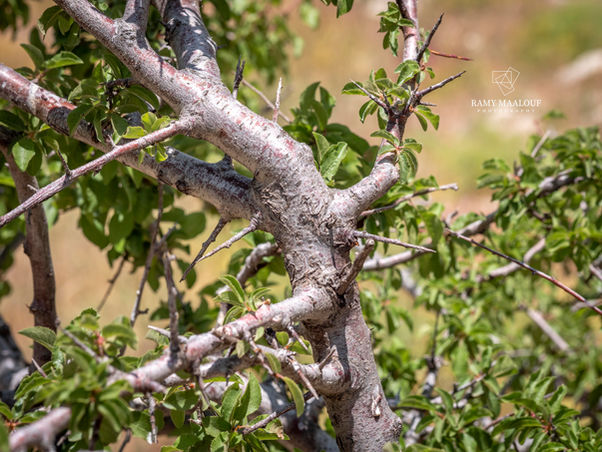Family |
Rosaceae
Prunus ursina
Kotschy ex Boiss.
Leb. Syr. Tur. Pal.
Prunus ursina Kotschy ex Boiss.
(Fl. Orient. 2: 652; 1872–1873 – Nouvelle Flore du Liban et de la Syrie, vol. 2, Pl. CXCIX nº 3; 1969)
• Life-form & habit: Deciduous spiny shrub or small tree, 1–5 m tall, forming dense thickets. Bark grey-brown, smooth at first, later fissured; young branchlets reddish-brown, glabrous or finely pubescent, often terminating in short, sharp spines.
• Leaves: Alternate, elliptic to obovate, 25–60 × 15–35 mm, serrulate, glabrous above, sparsely pubescent beneath along veins; apex obtuse to shortly acuminate; base rounded or cuneate. Petiole 5–10 mm long, bearing two small red glands near the apex.
• Inflorescence & flowers: Solitary or paired, appearing before the leaves in early spring. Pedicels 5–10 mm, slender and glabrous. Calyx campanulate, sepals reflexed at anthesis. Petals 5, white, 8–12 mm, rounded; stamens numerous; style filiform and exserted.
• Fruit: Drupe globose to ovoid, 10–15 mm in diameter, orange-red to dark red, covered with a fine bloom; flesh thin, firm, and astringent; stone smooth, ovate, slightly compressed.
• Phenology: Flowers from March to April; fruits ripen in June–July.
• Habitat & elevation: Dry rocky limestone slopes, forest margins, and open montane scrub, 800–2 000 m. Prefers calcareous, well-drained soils and sunny exposures, typical of Mediterranean subalpine habitats.
• Lebanese distribution: Reported by Mouterde (1969) from Mount Lebanon — notably Barouk, Ain Zhalta, Ehden, Sannine, Bcharreh, and Ain Dara — and in the Anti-Lebanon near Rashaya. Locally frequent in open juniper and oak scrub and on rocky slopes.
• Native to: Lebanon, Syria, Turkey, Palestine.
• ⚠️ Taxonomic note: Prunus ursina was described by Boissier (1872–73) as a distinct Levantine species, but Plants of the World Online (POWO) currently treats it as a synonym of Prunus cocomilia Ten. However, Mouterde (1969) and subsequent regional florists maintain P. ursina as a valid taxon restricted to the Amanus, Syria, and Lebanon, differing from P. cocomilia by its spiny branchlets, smaller, firmer fruits, and more compact, shrubby habit adapted to montane limestone habitats.
This species thus represents a Levantine endemic element within the Prunus cocomilia complex, characteristic of dry, high-elevation scrub and forest-edge vegetation in the central and northern Lebanese ranges.










